Detailed Analysis of Oral Health, Diseases, and Treatments (DN15)
VerifiedAdded on 2020/10/22
|19
|2855
|165
Homework Assignment
AI Summary
This assignment provides a comprehensive overview of oral health, addressing various oral diseases like caries, gingivitis, and periodontal disease, including their causes, progression, and effects. It details various treatment methods, including the use of fluoride supplements, disclosing tablets, tooth brushing, interdental aids, mouthwashes, and dental health messages. The assignment further explores the effects of dietary factors (sugar and acid content), smoking, alcohol, and substance misuse on oral health. It also examines how social factors such as family background, culture, and environment can impact oral health. The assignment also covers different communication methods, including verbal and non-verbal techniques, to communicate oral hygiene information. It explains the differences between systemic and topical fluoride, along with their advantages and disadvantages. Furthermore, the assignment discusses the functions of various equipment, instruments, materials, and medicaments used in periodontal therapy, prevention of dental caries, and cavity preparation, restoration, and finishing. It also evaluates different materials used in dental procedures, such as lining materials, etchants, bonding agents, and curing lights. The assignment also covers matrix systems, methods of cavity preparation, different types of prostheses, and the importance of the dental technician in the making of prostheses.

DN 15
Paraphrase This Document
Need a fresh take? Get an instant paraphrase of this document with our AI Paraphraser
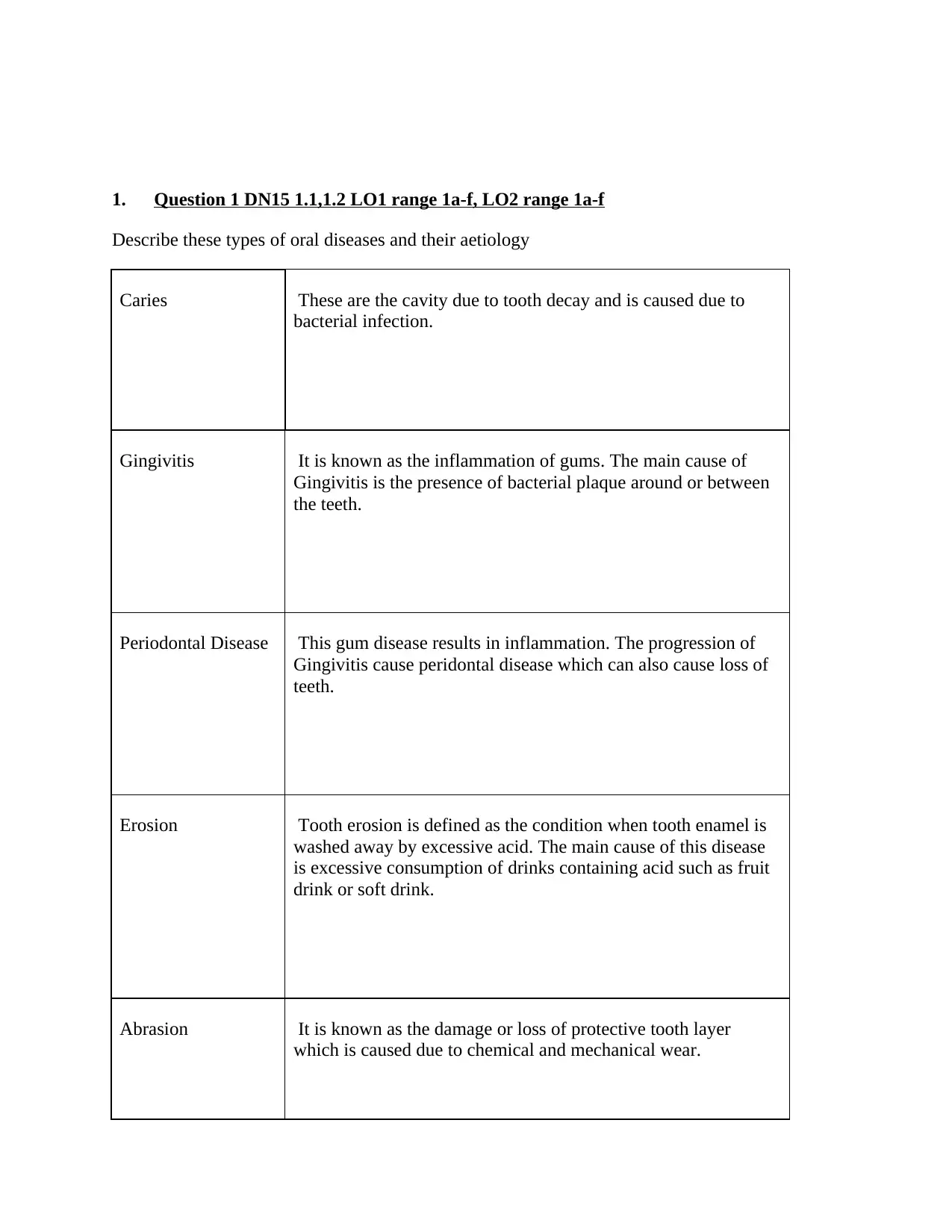
1. Question 1 DN15 1.1,1.2 LO1 range 1a-f, LO2 range 1a-f
Describe these types of oral diseases and their aetiology
Caries These are the cavity due to tooth decay and is caused due to
bacterial infection.
Gingivitis It is known as the inflammation of gums. The main cause of
Gingivitis is the presence of bacterial plaque around or between
the teeth.
Periodontal Disease This gum disease results in inflammation. The progression of
Gingivitis cause peridontal disease which can also cause loss of
teeth.
Erosion Tooth erosion is defined as the condition when tooth enamel is
washed away by excessive acid. The main cause of this disease
is excessive consumption of drinks containing acid such as fruit
drink or soft drink.
Abrasion It is known as the damage or loss of protective tooth layer
which is caused due to chemical and mechanical wear.
Describe these types of oral diseases and their aetiology
Caries These are the cavity due to tooth decay and is caused due to
bacterial infection.
Gingivitis It is known as the inflammation of gums. The main cause of
Gingivitis is the presence of bacterial plaque around or between
the teeth.
Periodontal Disease This gum disease results in inflammation. The progression of
Gingivitis cause peridontal disease which can also cause loss of
teeth.
Erosion Tooth erosion is defined as the condition when tooth enamel is
washed away by excessive acid. The main cause of this disease
is excessive consumption of drinks containing acid such as fruit
drink or soft drink.
Abrasion It is known as the damage or loss of protective tooth layer
which is caused due to chemical and mechanical wear.
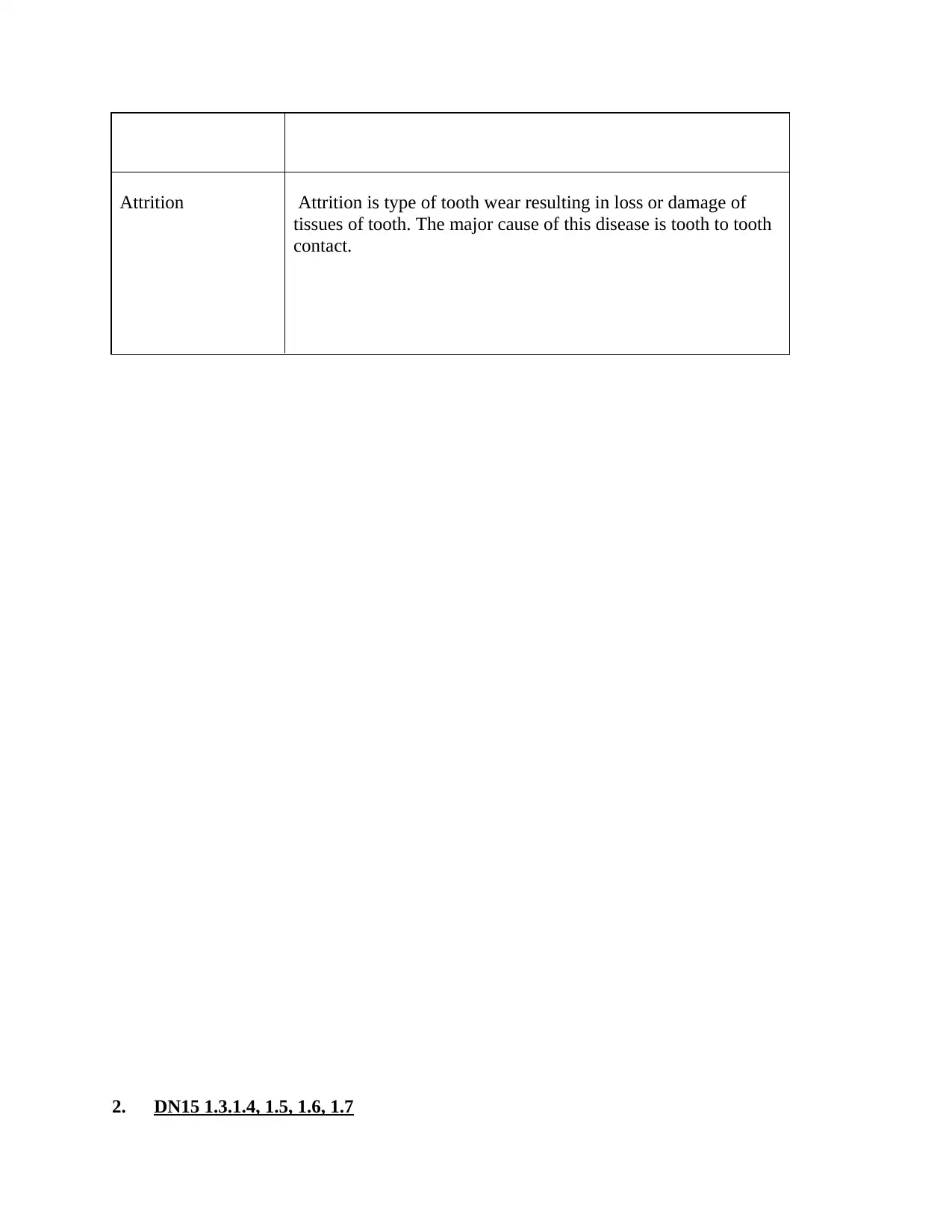
Attrition Attrition is type of tooth wear resulting in loss or damage of
tissues of tooth. The major cause of this disease is tooth to tooth
contact.
2. DN15 1.3.1.4, 1.5, 1.6, 1.7
tissues of tooth. The major cause of this disease is tooth to tooth
contact.
2. DN15 1.3.1.4, 1.5, 1.6, 1.7
⊘ This is a preview!⊘
Do you want full access?
Subscribe today to unlock all pages.

Trusted by 1+ million students worldwide
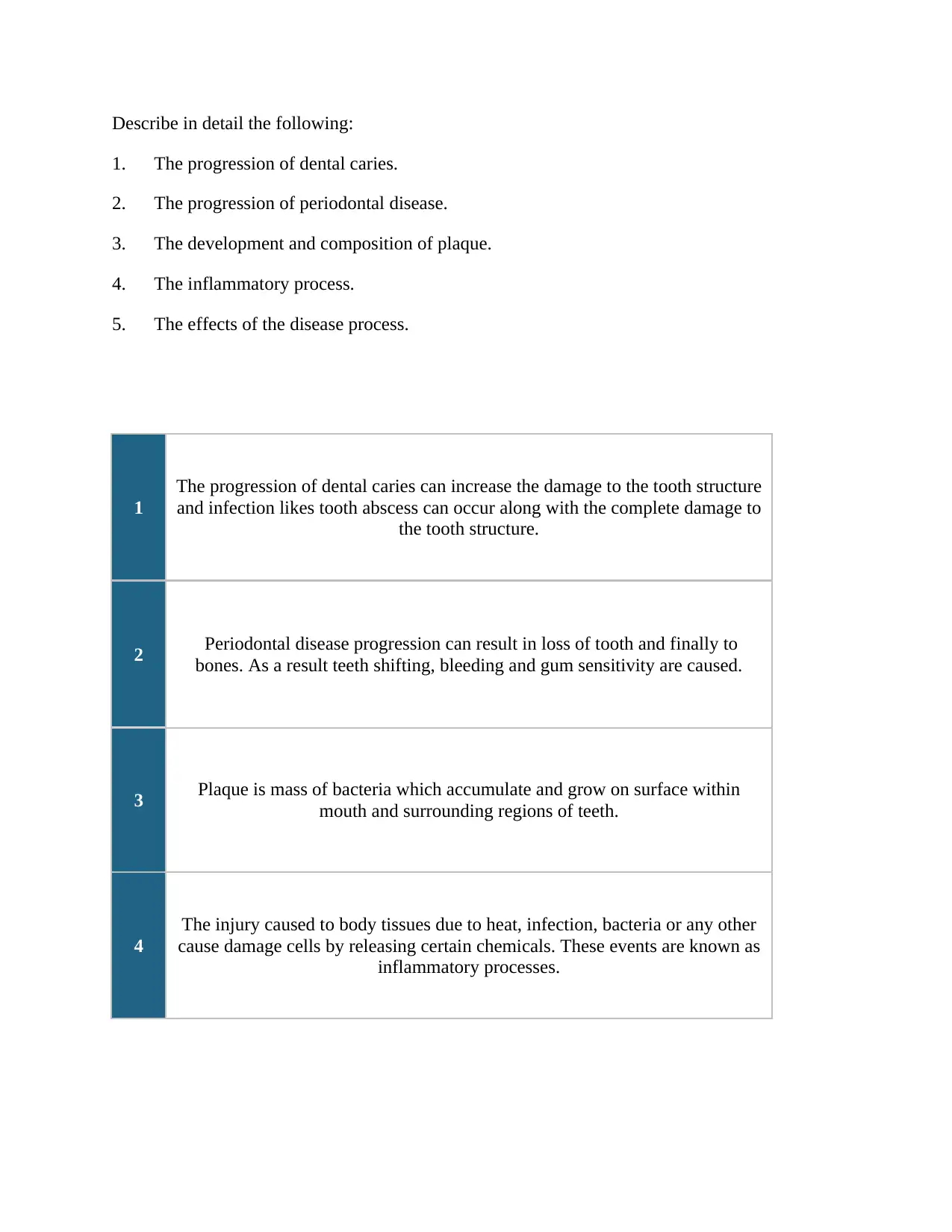
Describe in detail the following:
1. The progression of dental caries.
2. The progression of periodontal disease.
3. The development and composition of plaque.
4. The inflammatory process.
5. The effects of the disease process.
1
The progression of dental caries can increase the damage to the tooth structure
and infection likes tooth abscess can occur along with the complete damage to
the tooth structure.
2 Periodontal disease progression can result in loss of tooth and finally to
bones. As a result teeth shifting, bleeding and gum sensitivity are caused.
3 Plaque is mass of bacteria which accumulate and grow on surface within
mouth and surrounding regions of teeth.
4
The injury caused to body tissues due to heat, infection, bacteria or any other
cause damage cells by releasing certain chemicals. These events are known as
inflammatory processes.
1. The progression of dental caries.
2. The progression of periodontal disease.
3. The development and composition of plaque.
4. The inflammatory process.
5. The effects of the disease process.
1
The progression of dental caries can increase the damage to the tooth structure
and infection likes tooth abscess can occur along with the complete damage to
the tooth structure.
2 Periodontal disease progression can result in loss of tooth and finally to
bones. As a result teeth shifting, bleeding and gum sensitivity are caused.
3 Plaque is mass of bacteria which accumulate and grow on surface within
mouth and surrounding regions of teeth.
4
The injury caused to body tissues due to heat, infection, bacteria or any other
cause damage cells by releasing certain chemicals. These events are known as
inflammatory processes.
Paraphrase This Document
Need a fresh take? Get an instant paraphrase of this document with our AI Paraphraser
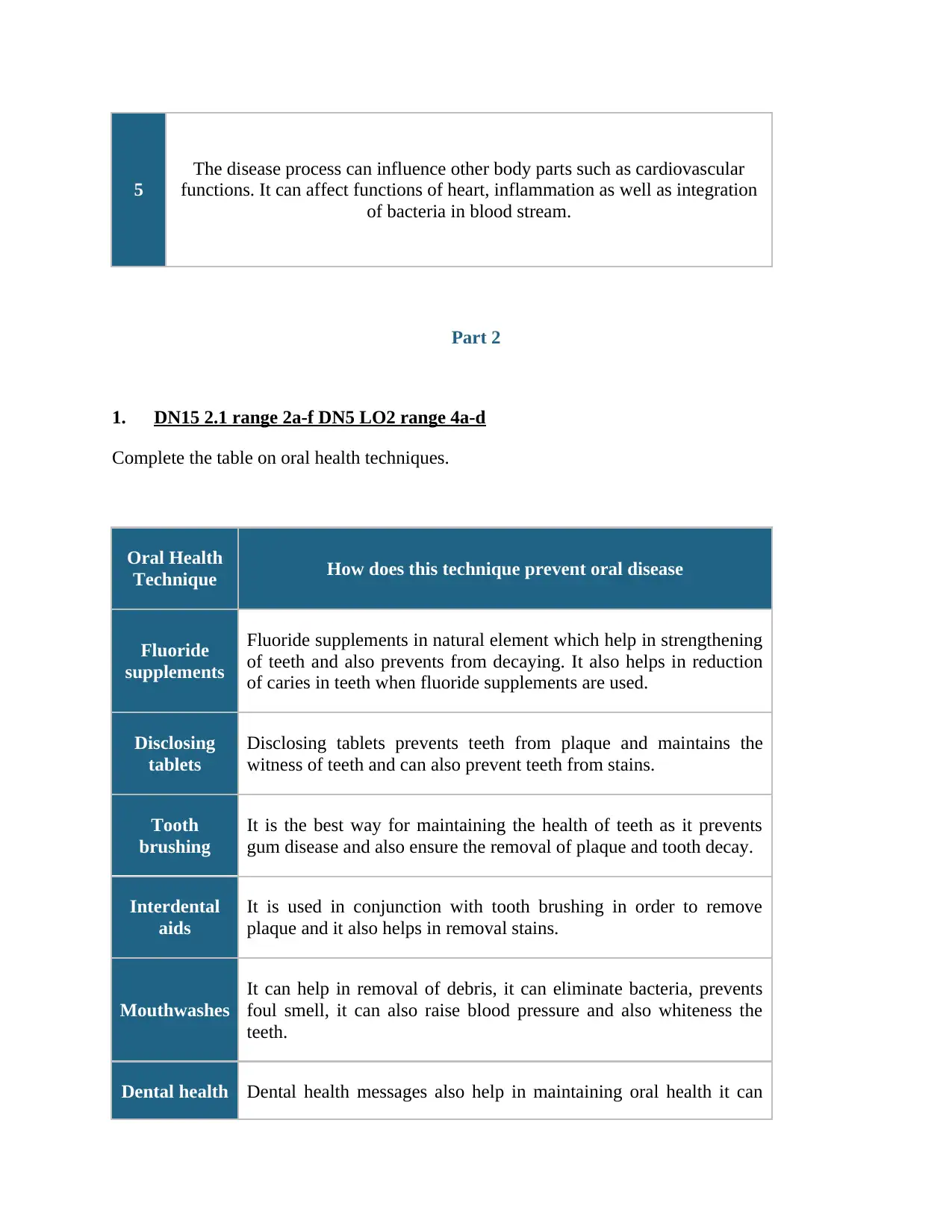
5
The disease process can influence other body parts such as cardiovascular
functions. It can affect functions of heart, inflammation as well as integration
of bacteria in blood stream.
Part 2
1. DN15 2.1 range 2a-f DN5 LO2 range 4a-d
Complete the table on oral health techniques.
Oral Health
Technique How does this technique prevent oral disease
Fluoride
supplements
Fluoride supplements in natural element which help in strengthening
of teeth and also prevents from decaying. It also helps in reduction
of caries in teeth when fluoride supplements are used.
Disclosing
tablets
Disclosing tablets prevents teeth from plaque and maintains the
witness of teeth and can also prevent teeth from stains.
Tooth
brushing
It is the best way for maintaining the health of teeth as it prevents
gum disease and also ensure the removal of plaque and tooth decay.
Interdental
aids
It is used in conjunction with tooth brushing in order to remove
plaque and it also helps in removal stains.
Mouthwashes
It can help in removal of debris, it can eliminate bacteria, prevents
foul smell, it can also raise blood pressure and also whiteness the
teeth.
Dental health Dental health messages also help in maintaining oral health it can
The disease process can influence other body parts such as cardiovascular
functions. It can affect functions of heart, inflammation as well as integration
of bacteria in blood stream.
Part 2
1. DN15 2.1 range 2a-f DN5 LO2 range 4a-d
Complete the table on oral health techniques.
Oral Health
Technique How does this technique prevent oral disease
Fluoride
supplements
Fluoride supplements in natural element which help in strengthening
of teeth and also prevents from decaying. It also helps in reduction
of caries in teeth when fluoride supplements are used.
Disclosing
tablets
Disclosing tablets prevents teeth from plaque and maintains the
witness of teeth and can also prevent teeth from stains.
Tooth
brushing
It is the best way for maintaining the health of teeth as it prevents
gum disease and also ensure the removal of plaque and tooth decay.
Interdental
aids
It is used in conjunction with tooth brushing in order to remove
plaque and it also helps in removal stains.
Mouthwashes
It can help in removal of debris, it can eliminate bacteria, prevents
foul smell, it can also raise blood pressure and also whiteness the
teeth.
Dental health Dental health messages also help in maintaining oral health it can
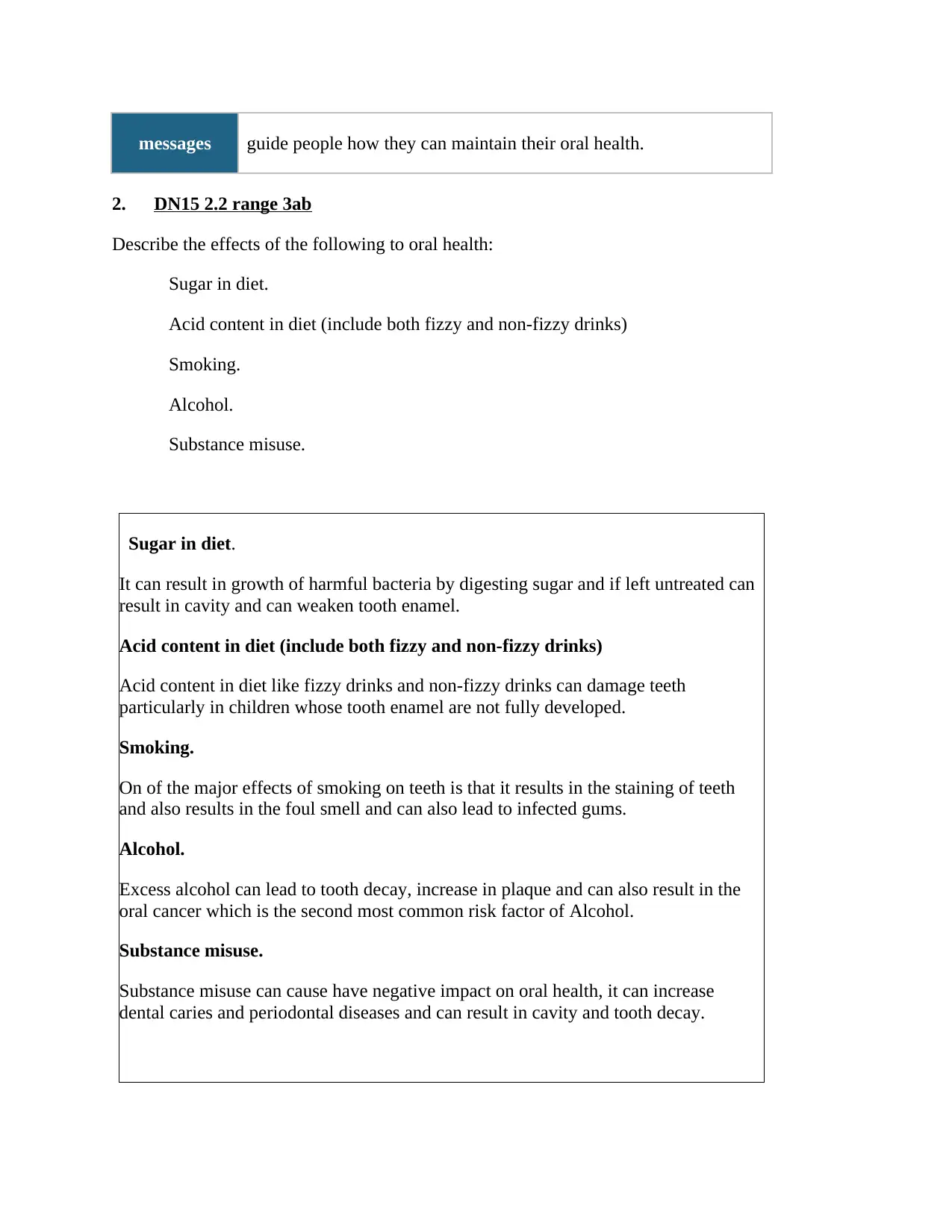
messages guide people how they can maintain their oral health.
2. DN15 2.2 range 3ab
Describe the effects of the following to oral health:
Sugar in diet.
Acid content in diet (include both fizzy and non-fizzy drinks)
Smoking.
Alcohol.
Substance misuse.
Sugar in diet.
It can result in growth of harmful bacteria by digesting sugar and if left untreated can
result in cavity and can weaken tooth enamel.
Acid content in diet (include both fizzy and non-fizzy drinks)
Acid content in diet like fizzy drinks and non-fizzy drinks can damage teeth
particularly in children whose tooth enamel are not fully developed.
Smoking.
On of the major effects of smoking on teeth is that it results in the staining of teeth
and also results in the foul smell and can also lead to infected gums.
Alcohol.
Excess alcohol can lead to tooth decay, increase in plaque and can also result in the
oral cancer which is the second most common risk factor of Alcohol.
Substance misuse.
Substance misuse can cause have negative impact on oral health, it can increase
dental caries and periodontal diseases and can result in cavity and tooth decay.
2. DN15 2.2 range 3ab
Describe the effects of the following to oral health:
Sugar in diet.
Acid content in diet (include both fizzy and non-fizzy drinks)
Smoking.
Alcohol.
Substance misuse.
Sugar in diet.
It can result in growth of harmful bacteria by digesting sugar and if left untreated can
result in cavity and can weaken tooth enamel.
Acid content in diet (include both fizzy and non-fizzy drinks)
Acid content in diet like fizzy drinks and non-fizzy drinks can damage teeth
particularly in children whose tooth enamel are not fully developed.
Smoking.
On of the major effects of smoking on teeth is that it results in the staining of teeth
and also results in the foul smell and can also lead to infected gums.
Alcohol.
Excess alcohol can lead to tooth decay, increase in plaque and can also result in the
oral cancer which is the second most common risk factor of Alcohol.
Substance misuse.
Substance misuse can cause have negative impact on oral health, it can increase
dental caries and periodontal diseases and can result in cavity and tooth decay.
⊘ This is a preview!⊘
Do you want full access?
Subscribe today to unlock all pages.

Trusted by 1+ million students worldwide
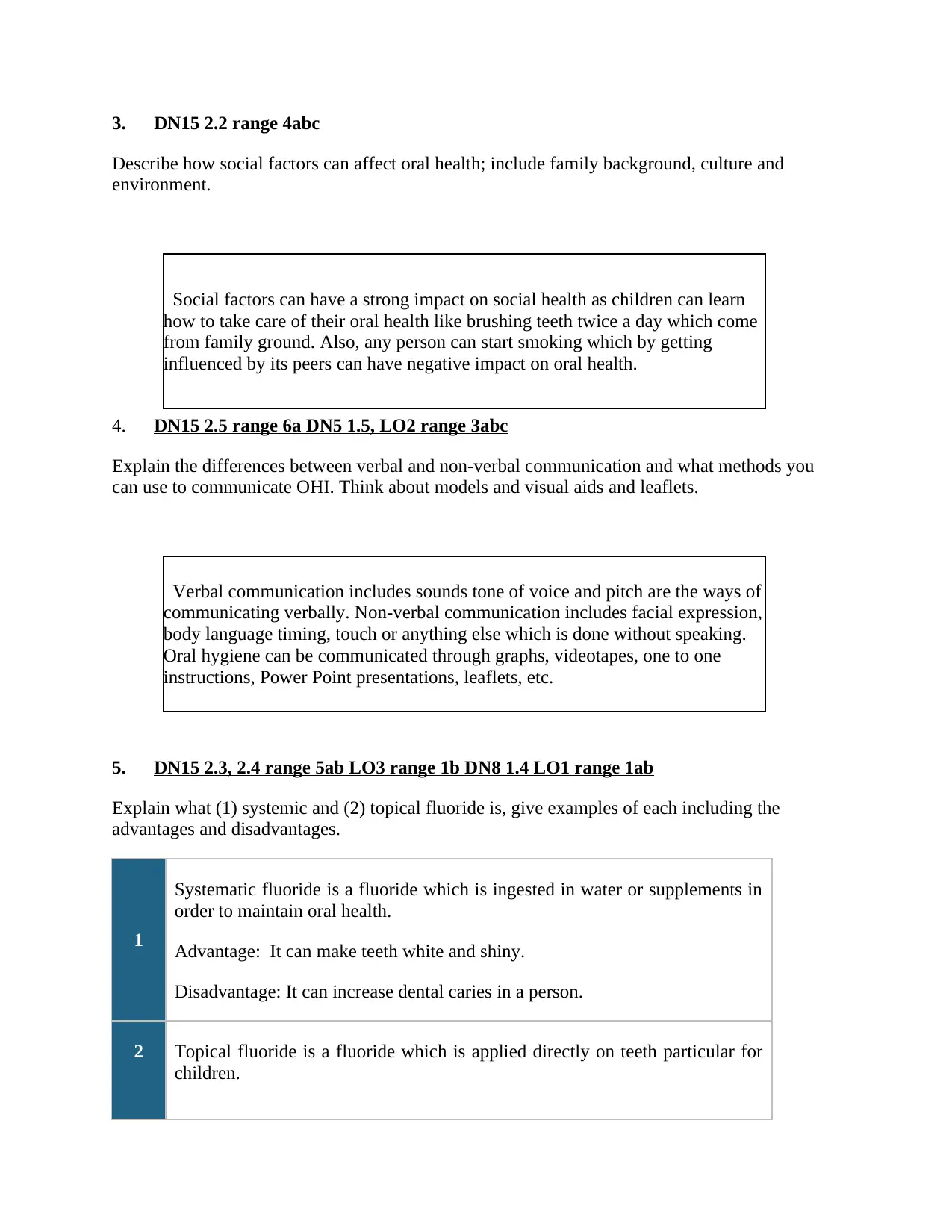
3. DN15 2.2 range 4abc
Describe how social factors can affect oral health; include family background, culture and
environment.
4. DN15 2.5 range 6a DN5 1.5, LO2 range 3abc
Explain the differences between verbal and non-verbal communication and what methods you
can use to communicate OHI. Think about models and visual aids and leaflets.
5. DN15 2.3, 2.4 range 5ab LO3 range 1b DN8 1.4 LO1 range 1ab
Explain what (1) systemic and (2) topical fluoride is, give examples of each including the
advantages and disadvantages.
1
Systematic fluoride is a fluoride which is ingested in water or supplements in
order to maintain oral health.
Advantage: It can make teeth white and shiny.
Disadvantage: It can increase dental caries in a person.
2 Topical fluoride is a fluoride which is applied directly on teeth particular for
children.
Social factors can have a strong impact on social health as children can learn
how to take care of their oral health like brushing teeth twice a day which come
from family ground. Also, any person can start smoking which by getting
influenced by its peers can have negative impact on oral health.
Verbal communication includes sounds tone of voice and pitch are the ways of
communicating verbally. Non-verbal communication includes facial expression,
body language timing, touch or anything else which is done without speaking.
Oral hygiene can be communicated through graphs, videotapes, one to one
instructions, Power Point presentations, leaflets, etc.
Describe how social factors can affect oral health; include family background, culture and
environment.
4. DN15 2.5 range 6a DN5 1.5, LO2 range 3abc
Explain the differences between verbal and non-verbal communication and what methods you
can use to communicate OHI. Think about models and visual aids and leaflets.
5. DN15 2.3, 2.4 range 5ab LO3 range 1b DN8 1.4 LO1 range 1ab
Explain what (1) systemic and (2) topical fluoride is, give examples of each including the
advantages and disadvantages.
1
Systematic fluoride is a fluoride which is ingested in water or supplements in
order to maintain oral health.
Advantage: It can make teeth white and shiny.
Disadvantage: It can increase dental caries in a person.
2 Topical fluoride is a fluoride which is applied directly on teeth particular for
children.
Social factors can have a strong impact on social health as children can learn
how to take care of their oral health like brushing teeth twice a day which come
from family ground. Also, any person can start smoking which by getting
influenced by its peers can have negative impact on oral health.
Verbal communication includes sounds tone of voice and pitch are the ways of
communicating verbally. Non-verbal communication includes facial expression,
body language timing, touch or anything else which is done without speaking.
Oral hygiene can be communicated through graphs, videotapes, one to one
instructions, Power Point presentations, leaflets, etc.
Paraphrase This Document
Need a fresh take? Get an instant paraphrase of this document with our AI Paraphraser
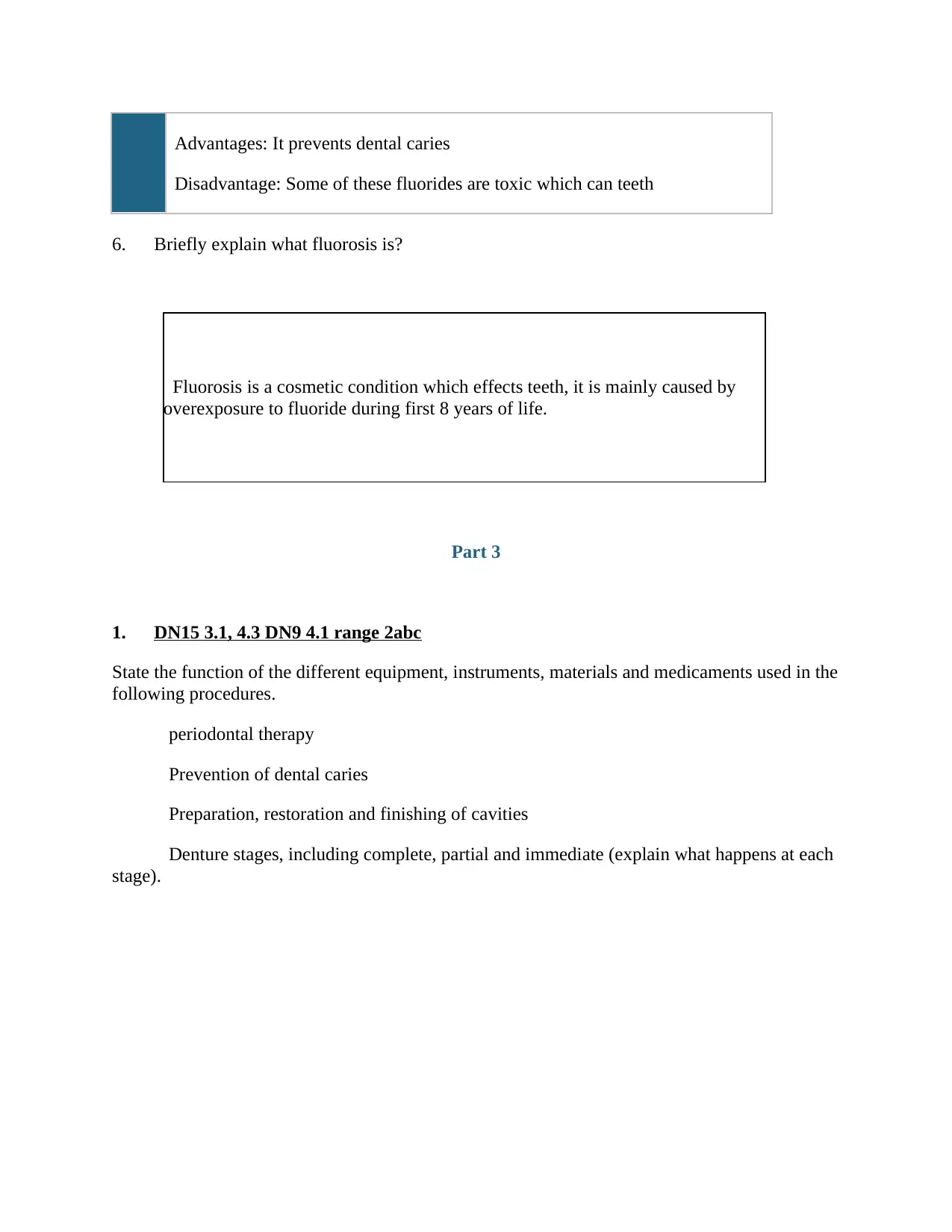
Advantages: It prevents dental caries
Disadvantage: Some of these fluorides are toxic which can teeth
6. Briefly explain what fluorosis is?
Part 3
1. DN15 3.1, 4.3 DN9 4.1 range 2abc
State the function of the different equipment, instruments, materials and medicaments used in the
following procedures.
periodontal therapy
Prevention of dental caries
Preparation, restoration and finishing of cavities
Denture stages, including complete, partial and immediate (explain what happens at each
stage).
Fluorosis is a cosmetic condition which effects teeth, it is mainly caused by
overexposure to fluoride during first 8 years of life.
Disadvantage: Some of these fluorides are toxic which can teeth
6. Briefly explain what fluorosis is?
Part 3
1. DN15 3.1, 4.3 DN9 4.1 range 2abc
State the function of the different equipment, instruments, materials and medicaments used in the
following procedures.
periodontal therapy
Prevention of dental caries
Preparation, restoration and finishing of cavities
Denture stages, including complete, partial and immediate (explain what happens at each
stage).
Fluorosis is a cosmetic condition which effects teeth, it is mainly caused by
overexposure to fluoride during first 8 years of life.
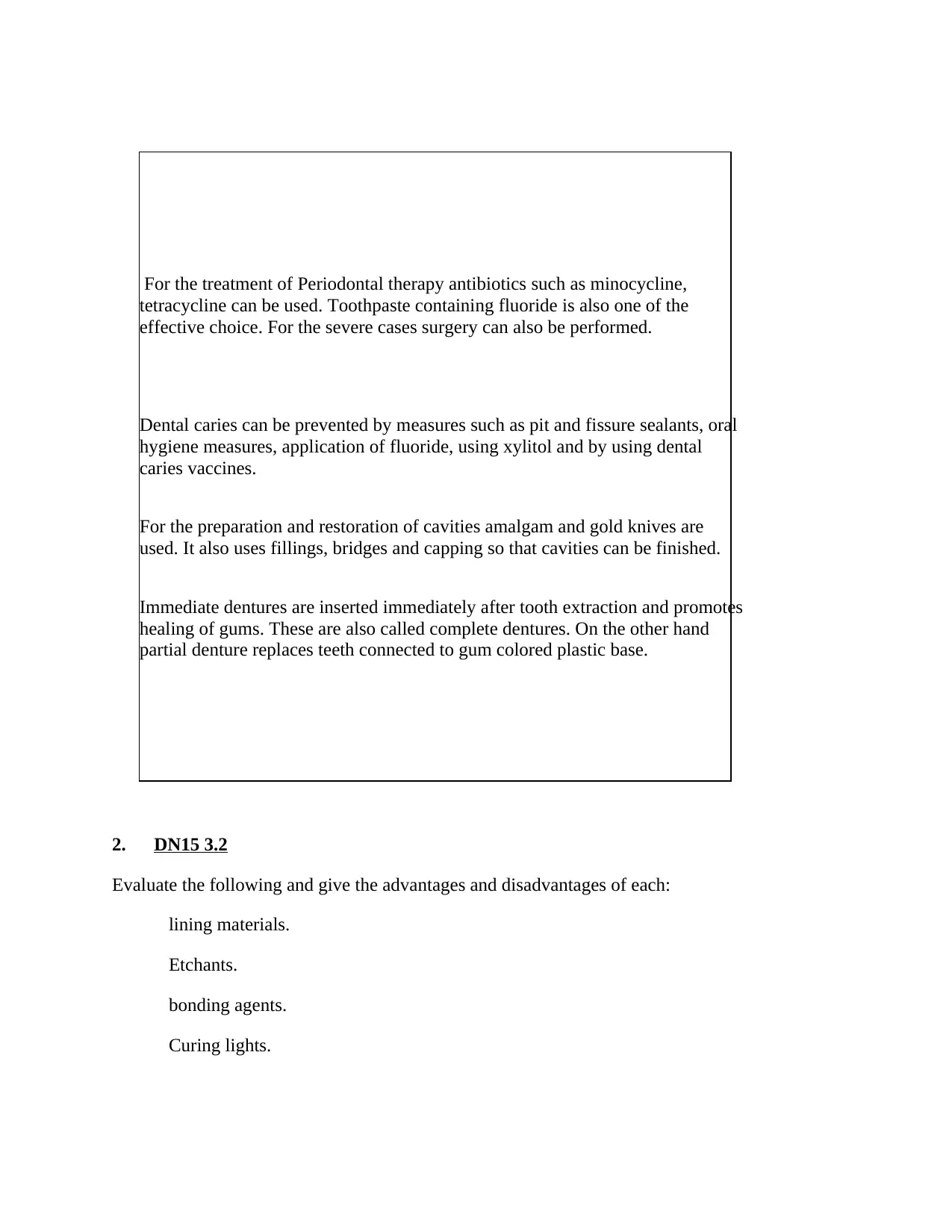
2. DN15 3.2
Evaluate the following and give the advantages and disadvantages of each:
lining materials.
Etchants.
bonding agents.
Curing lights.
For the treatment of Periodontal therapy antibiotics such as minocycline,
tetracycline can be used. Toothpaste containing fluoride is also one of the
effective choice. For the severe cases surgery can also be performed.
Dental caries can be prevented by measures such as pit and fissure sealants, oral
hygiene measures, application of fluoride, using xylitol and by using dental
caries vaccines.
For the preparation and restoration of cavities amalgam and gold knives are
used. It also uses fillings, bridges and capping so that cavities can be finished.
Immediate dentures are inserted immediately after tooth extraction and promotes
healing of gums. These are also called complete dentures. On the other hand
partial denture replaces teeth connected to gum colored plastic base.
Evaluate the following and give the advantages and disadvantages of each:
lining materials.
Etchants.
bonding agents.
Curing lights.
For the treatment of Periodontal therapy antibiotics such as minocycline,
tetracycline can be used. Toothpaste containing fluoride is also one of the
effective choice. For the severe cases surgery can also be performed.
Dental caries can be prevented by measures such as pit and fissure sealants, oral
hygiene measures, application of fluoride, using xylitol and by using dental
caries vaccines.
For the preparation and restoration of cavities amalgam and gold knives are
used. It also uses fillings, bridges and capping so that cavities can be finished.
Immediate dentures are inserted immediately after tooth extraction and promotes
healing of gums. These are also called complete dentures. On the other hand
partial denture replaces teeth connected to gum colored plastic base.
⊘ This is a preview!⊘
Do you want full access?
Subscribe today to unlock all pages.

Trusted by 1+ million students worldwide
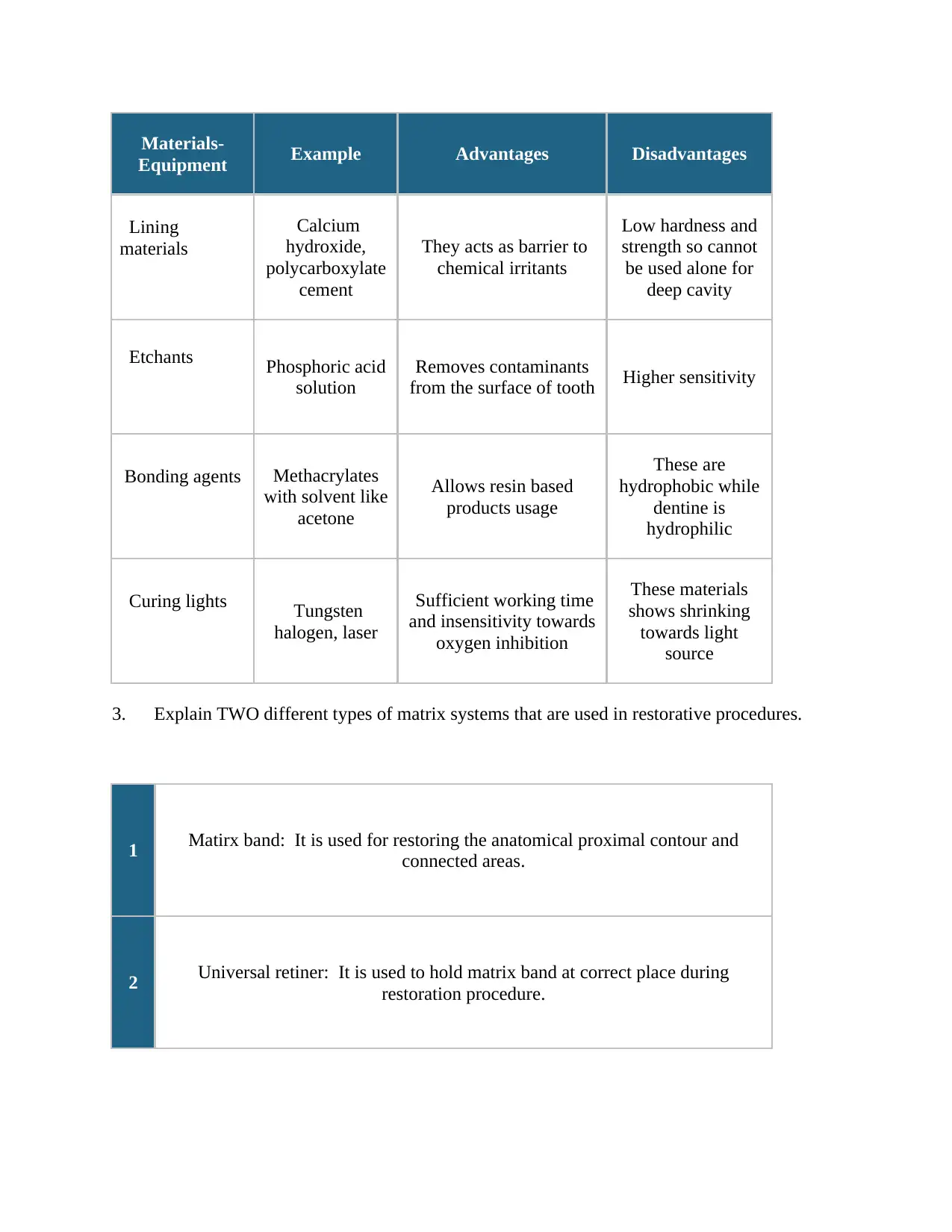
Materials-
Equipment Example Advantages Disadvantages
Lining
materials
Calcium
hydroxide,
polycarboxylate
cement
They acts as barrier to
chemical irritants
Low hardness and
strength so cannot
be used alone for
deep cavity
Etchants Phosphoric acid
solution
Removes contaminants
from the surface of tooth Higher sensitivity
Bonding agents Methacrylates
with solvent like
acetone
Allows resin based
products usage
These are
hydrophobic while
dentine is
hydrophilic
Curing lights Tungsten
halogen, laser
Sufficient working time
and insensitivity towards
oxygen inhibition
These materials
shows shrinking
towards light
source
3. Explain TWO different types of matrix systems that are used in restorative procedures.
1 Matirx band: It is used for restoring the anatomical proximal contour and
connected areas.
2 Universal retiner: It is used to hold matrix band at correct place during
restoration procedure.
Equipment Example Advantages Disadvantages
Lining
materials
Calcium
hydroxide,
polycarboxylate
cement
They acts as barrier to
chemical irritants
Low hardness and
strength so cannot
be used alone for
deep cavity
Etchants Phosphoric acid
solution
Removes contaminants
from the surface of tooth Higher sensitivity
Bonding agents Methacrylates
with solvent like
acetone
Allows resin based
products usage
These are
hydrophobic while
dentine is
hydrophilic
Curing lights Tungsten
halogen, laser
Sufficient working time
and insensitivity towards
oxygen inhibition
These materials
shows shrinking
towards light
source
3. Explain TWO different types of matrix systems that are used in restorative procedures.
1 Matirx band: It is used for restoring the anatomical proximal contour and
connected areas.
2 Universal retiner: It is used to hold matrix band at correct place during
restoration procedure.
Paraphrase This Document
Need a fresh take? Get an instant paraphrase of this document with our AI Paraphraser
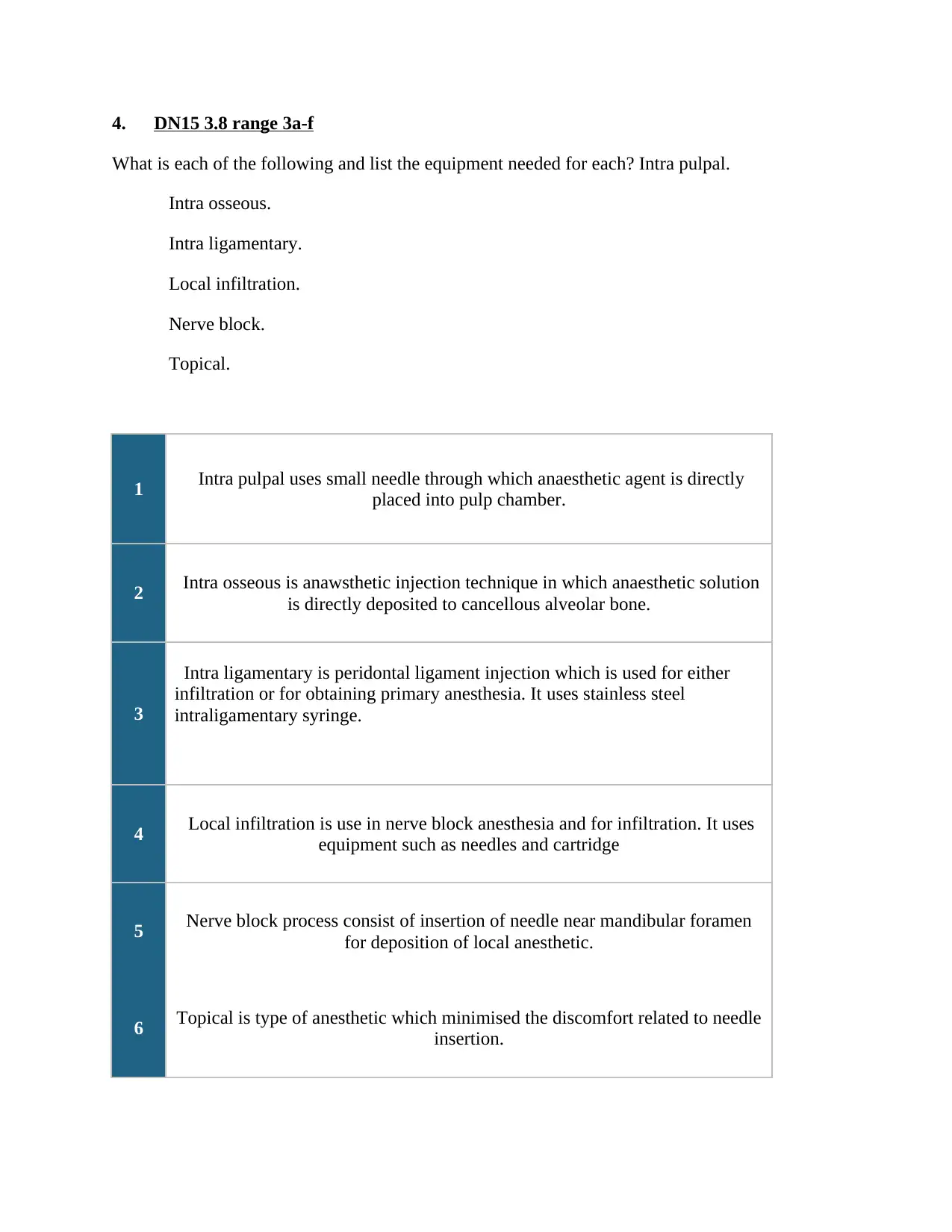
4. DN15 3.8 range 3a-f
What is each of the following and list the equipment needed for each? Intra pulpal.
Intra osseous.
Intra ligamentary.
Local infiltration.
Nerve block.
Topical.
1 Intra pulpal uses small needle through which anaesthetic agent is directly
placed into pulp chamber.
2 Intra osseous is anawsthetic injection technique in which anaesthetic solution
is directly deposited to cancellous alveolar bone.
3
Intra ligamentary is peridontal ligament injection which is used for either
infiltration or for obtaining primary anesthesia. It uses stainless steel
intraligamentary syringe.
4 Local infiltration is use in nerve block anesthesia and for infiltration. It uses
equipment such as needles and cartridge
5 Nerve block process consist of insertion of needle near mandibular foramen
for deposition of local anesthetic.
6 Topical is type of anesthetic which minimised the discomfort related to needle
insertion.
What is each of the following and list the equipment needed for each? Intra pulpal.
Intra osseous.
Intra ligamentary.
Local infiltration.
Nerve block.
Topical.
1 Intra pulpal uses small needle through which anaesthetic agent is directly
placed into pulp chamber.
2 Intra osseous is anawsthetic injection technique in which anaesthetic solution
is directly deposited to cancellous alveolar bone.
3
Intra ligamentary is peridontal ligament injection which is used for either
infiltration or for obtaining primary anesthesia. It uses stainless steel
intraligamentary syringe.
4 Local infiltration is use in nerve block anesthesia and for infiltration. It uses
equipment such as needles and cartridge
5 Nerve block process consist of insertion of needle near mandibular foramen
for deposition of local anesthetic.
6 Topical is type of anesthetic which minimised the discomfort related to needle
insertion.
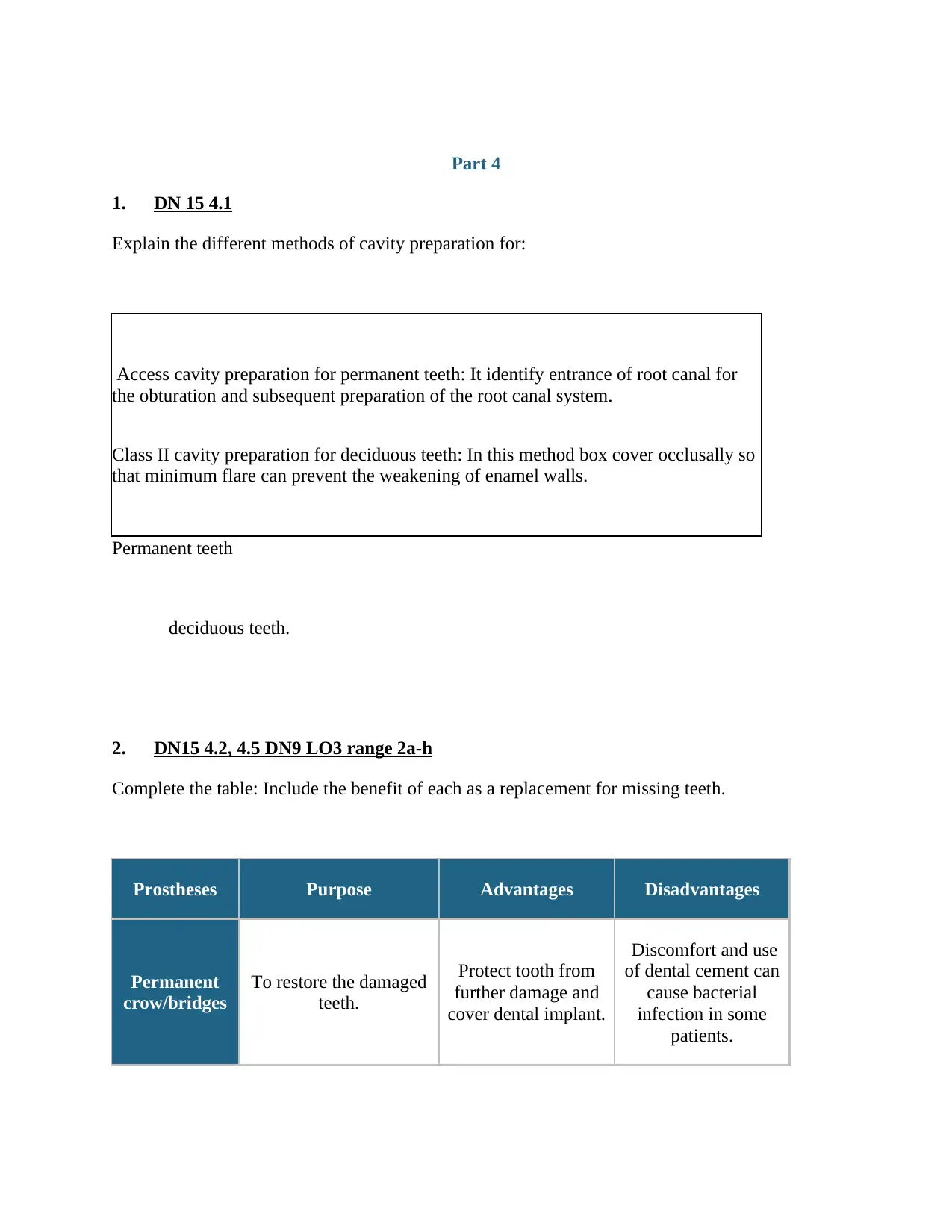
Part 4
1. DN 15 4.1
Explain the different methods of cavity preparation for:
Access cavity preparation for permanent teeth: It identify entrance of root canal for
the obturation and subsequent preparation of the root canal system.
Class II cavity preparation for deciduous teeth: In this method box cover occlusally so
that minimum flare can prevent the weakening of enamel walls.
Permanent teeth
deciduous teeth.
2. DN15 4.2, 4.5 DN9 LO3 range 2a-h
Complete the table: Include the benefit of each as a replacement for missing teeth.
Prostheses Purpose Advantages Disadvantages
Permanent
crow/bridges
To restore the damaged
teeth.
Protect tooth from
further damage and
cover dental implant.
Discomfort and use
of dental cement can
cause bacterial
infection in some
patients.
1. DN 15 4.1
Explain the different methods of cavity preparation for:
Access cavity preparation for permanent teeth: It identify entrance of root canal for
the obturation and subsequent preparation of the root canal system.
Class II cavity preparation for deciduous teeth: In this method box cover occlusally so
that minimum flare can prevent the weakening of enamel walls.
Permanent teeth
deciduous teeth.
2. DN15 4.2, 4.5 DN9 LO3 range 2a-h
Complete the table: Include the benefit of each as a replacement for missing teeth.
Prostheses Purpose Advantages Disadvantages
Permanent
crow/bridges
To restore the damaged
teeth.
Protect tooth from
further damage and
cover dental implant.
Discomfort and use
of dental cement can
cause bacterial
infection in some
patients.
⊘ This is a preview!⊘
Do you want full access?
Subscribe today to unlock all pages.

Trusted by 1+ million students worldwide
1 out of 19
Related Documents
Your All-in-One AI-Powered Toolkit for Academic Success.
+13062052269
info@desklib.com
Available 24*7 on WhatsApp / Email
![[object Object]](/_next/static/media/star-bottom.7253800d.svg)
Unlock your academic potential
Copyright © 2020–2025 A2Z Services. All Rights Reserved. Developed and managed by ZUCOL.





